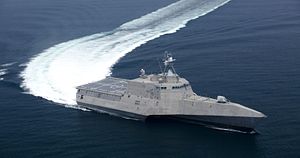The U.S. Navy is soliciting industry solutions for a future frigate design to guide future acquisition planning and decision making. The Request for Information (RFI) follows earlier signals from U.S. officials that it was expanding its study of options for its future Small Surface Combatant beyond earlier plans simply to upgrade existing Littoral Combat Ship (LCS) designs. The Navy is not seeking whole new designs, however; the RFI specifically solicits solutions based on existing hull designs to speed up procurement timelines and reduce costs. While some officials speculate that the two existing LCS designs will have a competitive advantage, there is doubt that they will be able to meet the expanded surface combat capabilities sought in the RFI.
The new RFI is for a “Guided Missile Frigate Replacement Program,” or FFG(X), while plans for upgraded LCSs that had been previously pursued did not have the Guided Missile designation — FFs, not FFGs. This was the first hint that the Navy was seeking combat capabilities beyond what the existing LCS designs may be capable of being modified to effectively deliver.
In addition to cost-overruns, major breakdowns, persistent doubts that it could meet its mission requirements, and serious crewing issues, the LCS program has long been criticized for its meager combat capabilities. The ships are fast but lacked both adequate self-defense capabilities against advanced missile threats and a potent weapon to engage other warships with, leading Senator John McCain, the Chairman of the Senate Armed Services Committee, to label the LCS an “alleged warship.” Recognizing this capability shortfall, in 2014 the Pentagon announced plans to upgrade the LCS’s armament and the Navy subsequently re-designated them as Fast Frigates (not Guided Missile Frigates).
This past May, the Acting Secretary of the Navy said that plans to move forward with a modified LCS hull as the Navy’s frigate were being delayed so that other builders could propose designs. At the time, he speculated that the two existing LCS designs may nevertheless have a competitive advantage because they had active production lines. But the specifications listed in the Navy’s FFG(X) RFI cast doubt on whether either LCS hull would be able to meet its expanded capability requirements.
In the first place, the LCS hulls may simply not be large enough. The RFI lists accommodations for a maximum 200 crewmembers, which is more than twice the crew capacity of the LCS hulls. Despite the promise of innovative work design and crewing practices to reduce crew size, early hulls were plagued by extreme fatigue issues and the current capacity for 93 crewmembers was only achieved after design modifications to add berthing for 20 more people.
This bigger crew is needed to meet the demands of the FFG(X)’s broader mission and additional equipment. The LCSs were originally conceived to operate independently in shallow littoral regions to relieve larger cruisers and destroyers of low-end missions. But the meager armament of the resulting designs left them not just incapable of contributing to a higher-end fight if needed, but also potential liabilities that would require other ships to provide defense for them against advanced air threats. The new FFG(X)s will retain the “low end” shallow water missions that the LCSs were intended for, but with enough additional weapons to be able to integrate effectively into a Carrier Strike Group or as part of a Surface Action Group and contribute to higher-intensity combat operations.
The upgraded LCS-based FFs were to have permanently installed anti-submarine warfare systems, Hellfire missiles for use against small, fast-moving targets, long-range over-the-horizon anti-ship missiles, and upgraded close-in air defense systems. In addition to all this, the FFG(X) must also have the capability to launch more robust air-defense missiles like the Evolved Sea Sparrow Missile and/or the SM-2. These additional missiles would give the FFG(X) the ability to not just defend itself, but also contribute to area air-defense as part of a larger group, or independently provide effective escort for convoys and logistics vessels, freeing up cruisers and destroyers for other missions.
Beyond their smaller crew capacity, the problem with the existing LCS hulls is that it is unclear whether they are large enough to effectively accommodate these additional weapons systems. This is why the analysts behind one of the most talked-about proposals for the Navy’s future fleet design from the Center for Strategic and Budgetary Assessments advocated a frigate of 4000-5000 tons, significantly larger than the 3000 ton LCSs.
The new emphasis on anti-surface and area air-defense missions for the FFG(X) reflects the U.S. Navy’s Distributed Lethality concept. Facing rapidly expanding near-peer threats with advanced anti-ship capabilities like China, the U.S. Navy is trying to mitigate the difficulty of rapidly increasing the size of its own fleet to meet this challenge by increasing the defensive and sea combat capabilities of the ships it has.
As Rear Admiral Ronald Boxall, the U.S. Navy’s Director of Surface warfare, explained to an audience in January, “If you don’t have an over-the-horizon missile on that ship, no one’s worrying about those ships. If you put a good missile on that ship, people are going to have to pay attention to it.” The Navy appears to have decided that even that isn’t enough, and nearly a decade after the first LCS was commissioned it looks less and less like their hulls will be able to deliver the capabilities that the Navy needs.
































